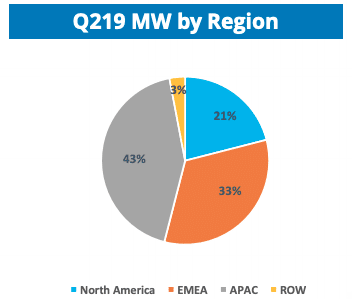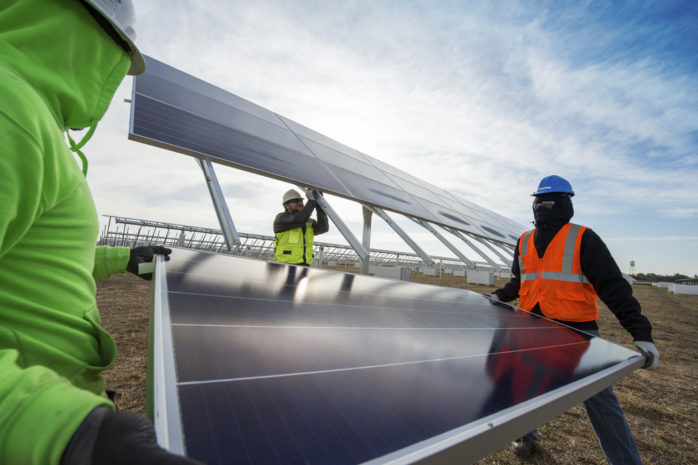From pv magazine USA.
SunPower is a study in paradox. It makes the most efficient solar panels commercially available for rooftops in the world, has one of the largest presences in the residential solar sector and is innovating in grid services and customer interfaces.
Profitability, however, is another matter. SunPower reported a 15% operating margin and $121 million net income from $436 million revenue during the second quarter but that was down to the $137 million banked from leases it sold. The manufacturer expects to report another loss from the third quarter.
This despite promises of “sustainable profitability” in the second half as the goalposts keep moving and the prospect of getting into the black remains elusive. SunPower, however, can at least say losses are continually reducing. And even when the lease sale income is removed, SunPower’s margins have consistently improved in recent quarters.
The cash situation is not as comforting. The $200 million in cash and equivalents SunPower reported at the end of the quarter was a big drop from the $364 million at the beginning of the year. There is no emergency, though, with the company expecting its business units to bring in more cash during the second half. Furthermore, during the quarter the company partnered with Bank of America and Hannon Armstrong on a residential lease financing structure.
Distributed power
SunPower saw a number of positive developments during Q2 and leading the list was the beginning of shipments of its A-Series module into the U.S. market. The module is a powerhouse, clocking in at 415 watts as the first product for the rooftop market to exceed 400 W.
 That is the result of bigger, better everything – bigger wafers and a larger module format but also 25% efficient cells setting a new high even for SunPower’s back-contact technology.
That is the result of bigger, better everything – bigger wafers and a larger module format but also 25% efficient cells setting a new high even for SunPower’s back-contact technology.
The rollout of the A-Series coincided with the Californian company’s largest deployment of modules to date – at 622 MW, growth of more than 30% supported by new A and P-Series module lines. San Jose-based SunPower credits the North American residential business for its growth in the quarter and the 70 MW deployed into the U.S. residential market put it not far behind Sunrun as the second-largest company in the space.
During the three-month period, SunPower also deployed 47 MW of solar in the commercial and industrial market, as well as 15 MW of energy storage. In the current reporting window it expects to roll out the Equinox combined solar and battery solution for residential customers.
Overall, the scope of services offered by the SunPower Energy Services division continues to grow. The company has 75,000 customers under residential leases and is also providing operation and maintenance services to 1.3 GW of commercial and residential PV system generation capacity.
The U.S. manufacturer’s EnergyLink monitoring platform has more than 100,000 users and SunPower has unveiled a new AI-powered design tool for customers that could streamline design and sales. Such value-added solutions have the potential to increase what CEO Tom Werner described as “customer stickiness”.
SunPower’s customer base is not restricted to rooftop clients either. Last year the company successfully bid into the ISO (independent system operator) New England capacity market and it said it plans to further expand that activity as well as providing demand response in California.
Global reach
While it expands its distributed energy services offering, SunPower is also retooling and expanding its manufacturing operation. The company is installing tools on the second 125 MW line for its A-Series product and said it has fully ramped P-Series production at the former SolarWorld factory in Oregon.
 SunPower has a lot more P-Series product through a 2 GW production joint venture in China and the latest update revealed the majority of its deployments are now in the Asia-Pacific region. Due to strong demand for multiple products across several regions, SunPower reported it is fully booked for the year.
SunPower has a lot more P-Series product through a 2 GW production joint venture in China and the latest update revealed the majority of its deployments are now in the Asia-Pacific region. Due to strong demand for multiple products across several regions, SunPower reported it is fully booked for the year.
The current six months will see more A-Series production coming online in preparation for a full switchover of SunPower’s back-contact output.
While the company expects ongoing growth in the second half, however, it is still enduring the costs of legacy polysilicon contracts. Even with $1.8-2 billion in revenue this year, CEO Werner expects the elusive positive operating margins and profit will not arrive until the second half of next year.
This content is protected by copyright and may not be reused. If you want to cooperate with us and would like to reuse some of our content, please contact: editors@pv-magazine.com.



By submitting this form you agree to pv magazine using your data for the purposes of publishing your comment.
Your personal data will only be disclosed or otherwise transmitted to third parties for the purposes of spam filtering or if this is necessary for technical maintenance of the website. Any other transfer to third parties will not take place unless this is justified on the basis of applicable data protection regulations or if pv magazine is legally obliged to do so.
You may revoke this consent at any time with effect for the future, in which case your personal data will be deleted immediately. Otherwise, your data will be deleted if pv magazine has processed your request or the purpose of data storage is fulfilled.
Further information on data privacy can be found in our Data Protection Policy.